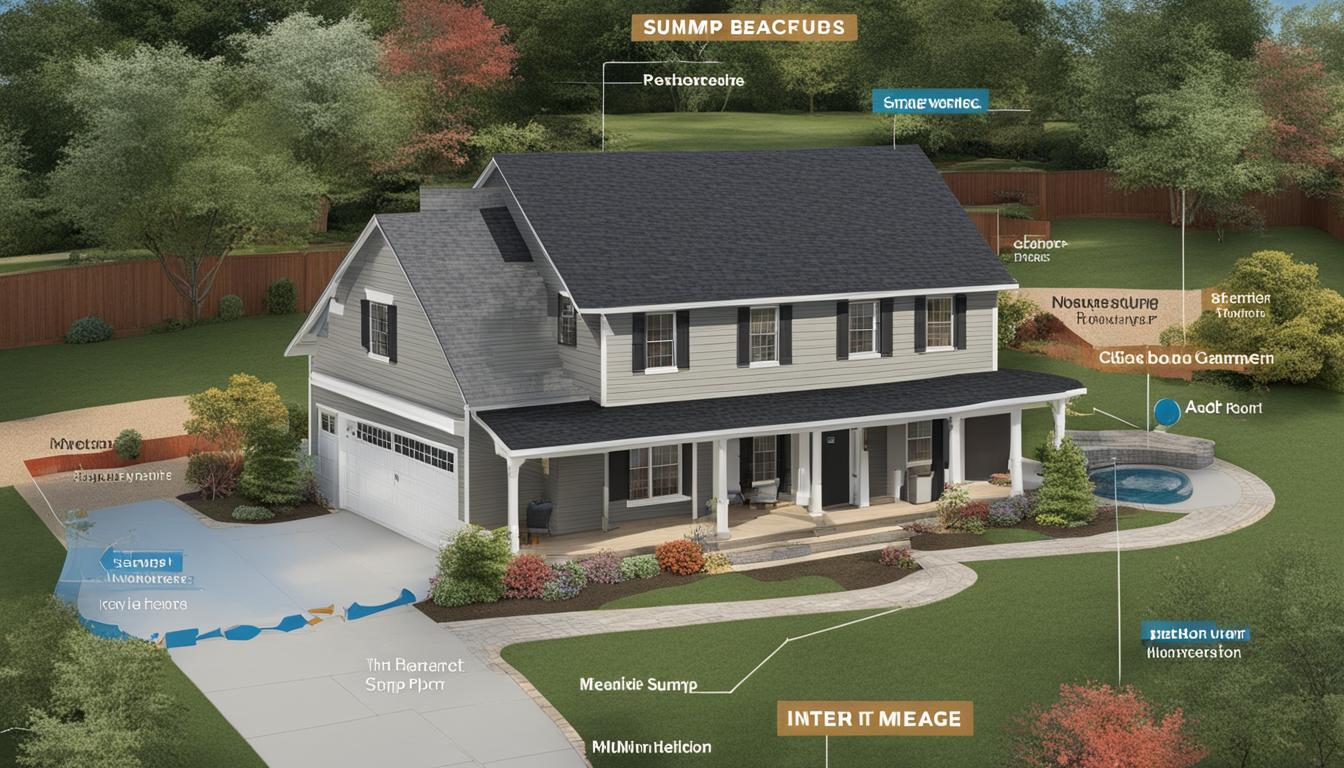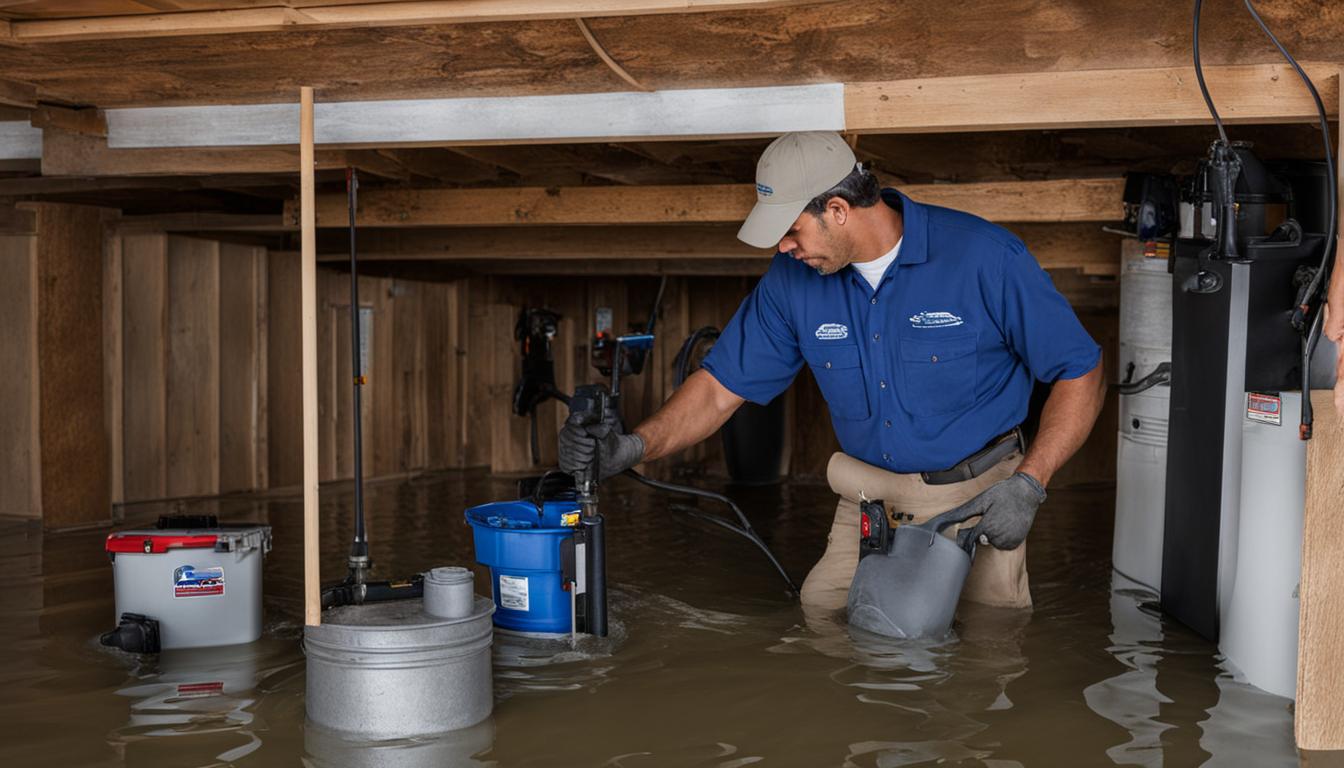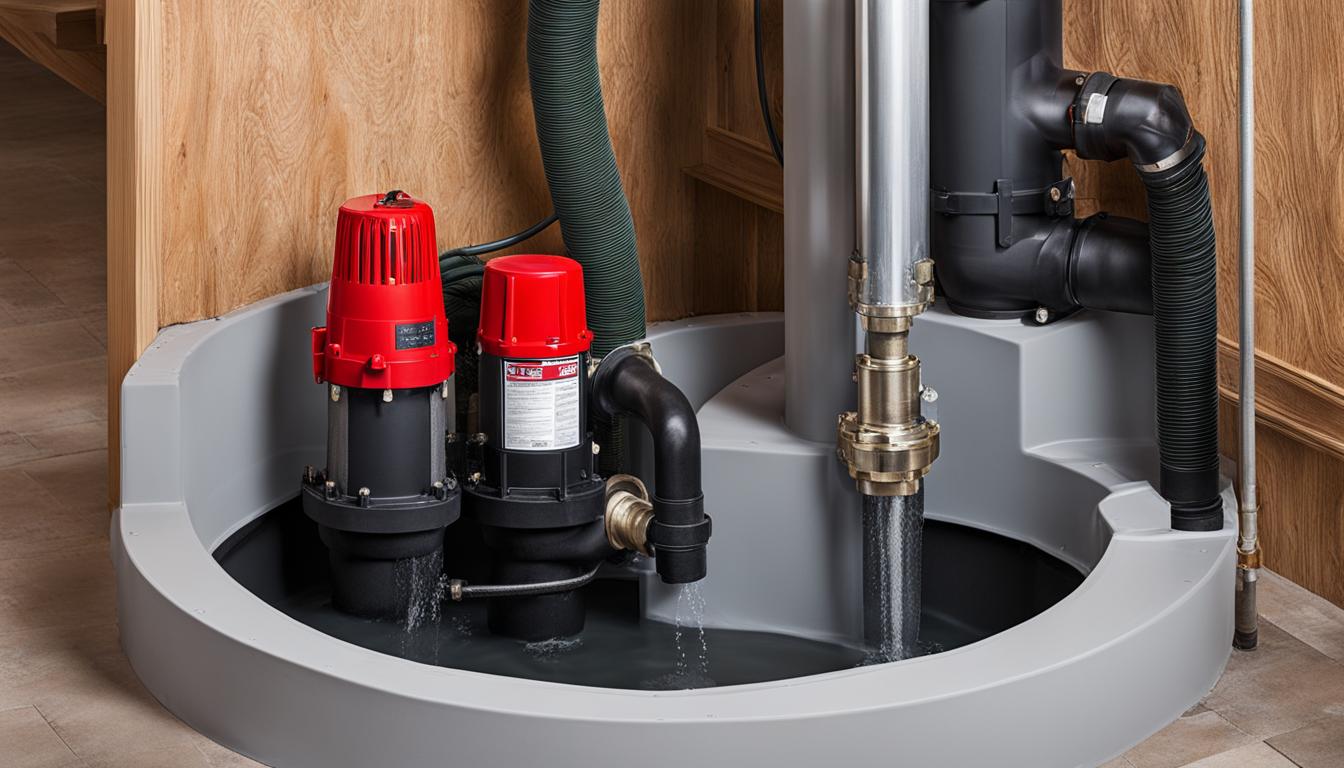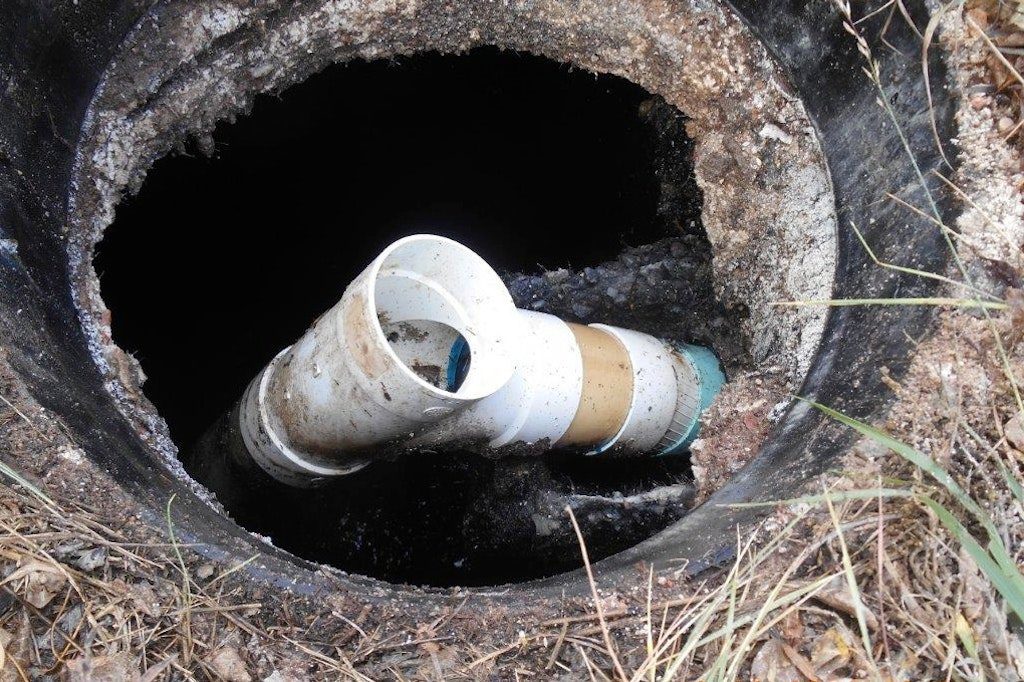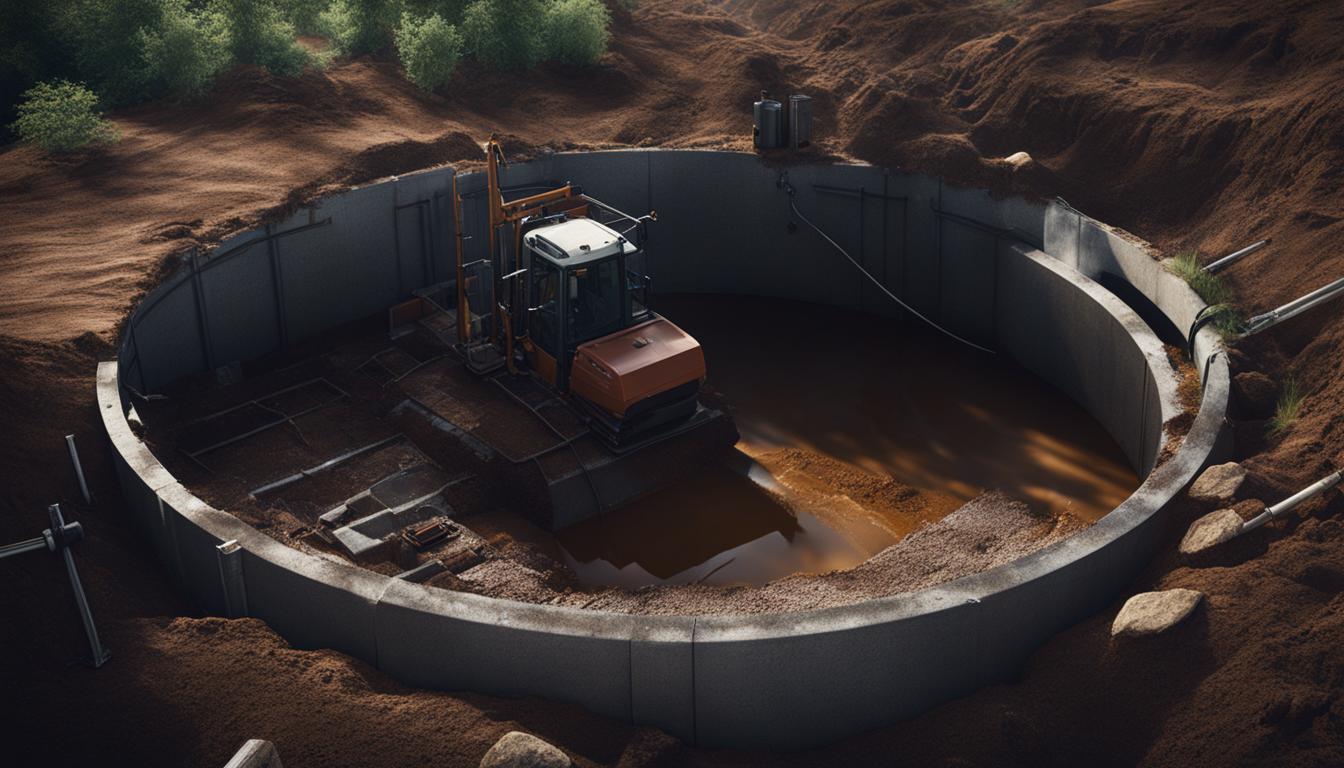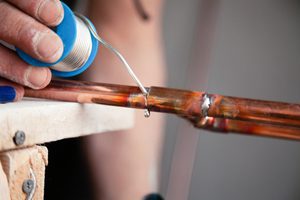When it comes to protecting your home from potential flooding, a sump pump can be an invaluable asset. However, installing it in the wrong location could affect its performance, reduce its lifespan, and ultimately put your home at risk. In this section, we will explore the best locations for sump pump installation, taking into account various factors that could affect its effectiveness.
Key Takeaways:
- Choosing the best location for sump pump installation is crucial for optimal performance and home protection.
- Factors such as flood risk areas, house layout, and water flow patterns should be considered before installation.
- The basement is a common area for sump pump installation, but proper positioning and space utilization are essential.
- Efficient installation strategies can not only prevent flooding but also improve overall efficiency, saving you energy and maintenance costs.
- Proper maintenance is crucial for the longevity and performance of your sump pump.
Factors to Consider for Sump Pump Placement
When it comes to sump pump installation, selecting the optimal location is crucial for preventing basement flooding and ensuring the longevity of your sump pump. Here are some factors to consider for sump pump placement:
Flood Risk Areas
The first thing to consider is flood risk areas in your home. These areas are more susceptible to water accumulation and require a reliable sump pump to prevent flooding. For instance, if your home is situated at a lower elevation or has poor drainage, the basement is likely to be at a higher risk of flooding.
| Factors to Consider | Level of Risk |
|---|---|
| Location in a floodplain | High |
| Basement below the water table | High |
| Proximity to water bodies | Medium |
By analyzing these factors, you can determine the level of risk and how necessary a sump pump is for your home.
House Layout
The layout of your home plays a significant role in deciding the placement of your sump pump. If your home has multiple levels, consider installing a sump pump on each level to maximize water removal and prevent flooding.
Additionally, proximity to plumbing and electrical systems should also be considered when placing a sump pump in your home.
Water Flow Patterns
Understanding water flow patterns is crucial for effective sump pump placement. It’s important to ensure that the sump pump is positioned in a way that allows it to remove water efficiently. If the sump pump isn’t correctly placed, it can have a negative impact on its effectiveness in removing water.
Efficient Installation Strategies
Expert installation is essential to ensure the longevity and effectiveness of your sump pump. It’s best to seek professional help for installation if you’re uncertain about the process. Proper installation includes ensuring that the sump pump is installed at the correct depth, ensuring the float switch is correctly positioned, and testing the pump to ensure it’s working effectively.
By considering these factors, you can identify the optimal location for your sump pump and ensure maximum effectiveness in preventing basement flooding.
Basement Positioning for Sump Pump Installation
The basement is a common area for sump pump installation, as it is often the lowest point in the house and therefore more prone to flooding. To ensure that your sump pump functions optimally, here are some installation tips:
- Choose the right location: Place your sump pump in the lowest part of the basement. This will ensure that water flows towards it, so it can pump the water out effectively.
- Ensure proper drainage: Your sump pump should have a discharge pipe that carries water away from your home. Make sure the pipe is directed away from your foundation and any nearby structures.
- Install a durable sump pump basin: The basin is where the sump pump sits and collects water. Use a durable material like polyethylene to prevent cracks or other damage that could impact the sump pump’s performance.
- Test your sump pump: After installation, test your sump pump to make sure that it’s working correctly. Pour a bucket of water into the basin and watch as the sump pump turns on and pumps the water out.
Pro Tip: Install a battery backup system to your sump pump in case of power outage. This will ensure that your sump pump continues to function even during a storm.
By following these basement positioning tips, you can maximize the effectiveness of your sump pump in preventing basement flooding. Remember to check your sump pump regularly and perform any necessary maintenance to ensure it remains in top condition.
Assessing Flood Risk Areas in Your Home
Before installing a sump pump, it’s essential to assess the flood risk areas in your home to determine the best location for your sump pump. Flood risk areas are those parts of your home that are more susceptible to flooding.
The first step in assessing flood risk areas is to consider the layout of your house. Evaluate the terrain, the incline of your property, and how water moves across it. Identifying low-lying areas, such as basements, is crucial, as these areas are often more prone to flooding.
You may also want to consider the proximity of your home to bodies of water, such as rivers or lakes, as these areas can pose a higher flood risk. If your home is in a flood-prone area, it’s essential to take extra precautions to protect your property from potential damage.
House Layout
Examining your house layout is essential for identifying flood risk areas. Identifying the location of your water supply line, plumbing, and other water sources can help you gain a better understanding of your home’s water flow patterns.
If your basement is below the water line, it’s crucial to install a sump pump to prevent groundwater from seeping in and causing damage. If water frequently enters your basement or crawlspace, it’s best to keep it dry by installing a sump pump. A sump pump can efficiently remove water that has accumulated in your basement, keeping it dry and preventing the potential for damage.
Assessing Flood Risk Areas
Here is a table that outlines some of the common flood risk areas in your home:
| Flood Risk Area | Factors to Consider |
|---|---|
| Basements | Lowest point in the house, below water line, prone to flooding |
| Crawlspaces | Lowest point in the house, below water line, damp and humid conditions |
| Exterior doors | Prone to water infiltration during heavy rain or flooding events |
| Windows | Vulnerable to water infiltration during heavy rain or flooding events |
| Driveways and yards | Exposed to heavy rain and runoff, can cause water accumulation |
Assessing flood risk areas in your home is crucial for determining the best location for your sump pump. By identifying vulnerable areas and understanding your home’s water flow patterns, you can ensure optimal performance and prevent potential flooding in your home.
Understanding Water Flow Patterns
When installing a sump pump, it’s crucial to consider water flow patterns to ensure its optimal performance. Water can enter your basement through various sources, including surface water, groundwater, and basement leaks. Understanding how water flows into your basement will help you choose the best installation strategy to direct water away from your home.
One way to prevent basement flooding is by installing a French drain. This drainage system consists of a trench filled with gravel or rock and a perforated pipe. The system collects water and directs it away from your basement and foundation. Installing a sump pump with a French drain can provide efficient water flow management, preventing water buildup in your basement.
Installation Strategies
There are different installation strategies that can be used based on your basement’s layout and water flow patterns. Some of these strategies include:
- Centrally located sump pump: This is the most common installation strategy where the sump pump is placed in the lowest area of your basement to collect all water that flows into it.
- Multipump installation: This strategy involves the installation of multiple sump pumps in different locations of your basement for added protection. This installation is necessary in large basements or locations with high water tables.
- Battery backup sump pump: This installation provides extra protection in case of power outages that may occur during storms or flooding. A battery backup sump pump ensures your basement stays dry even during power outages.
Understanding water flow patterns and choosing the best installation strategy for your basement will help prevent potential flooding and water damage to your home.
Maximizing Space Utilization for Sump Pump Installation
When installing a sump pump, careful consideration of space utilization is crucial. You want to ensure that your sump pump is installed in a location that maximizes its effectiveness and accessibility. Here are some installation tips to help you make the most of your available space:
- Choose an appropriate sump pit size: The size of the sump pit will have a direct impact on the size of the sump pump that you can install. Be sure to measure the dimensions of the available space to ensure that you choose the appropriate sump pit size.
- Ensure easy access: Your sump pump should be installed in a location that allows for easy access for both installation and maintenance. Be sure that there is enough space around the sump pump to perform any necessary repairs and cleaning.
- Consider installing a battery backup: Installing a battery backup for your sump pump can help ensure that it continues to operate in the event of a power outage. However, adding a battery backup will require additional space for the battery unit.
- Optimize pipe placement: Proper pipe placement is essential to ensure that water flows efficiently from the sump pit to the discharge point. Consider the layout of your home and the location of the sump pump when deciding where to place the pipes.
- Consult with a professional: If you are unsure about the best location for your sump pump or how to optimize your available space, consult with a professional. They can provide expert advice and ensure that your sump pump is installed correctly.
Improving Efficiency with Sump Pump Installation
At our company, we understand that sump pump installation is not only about preventing flooding, but also about improving overall efficiency. By following the right installation strategies, you can save on energy costs and reduce maintenance needs. Here are some tips to help you achieve optimal efficiency with your sump pump:
Consider Pump Size
When selecting a sump pump, it’s essential to choose the correct size for your needs. A pump that is too small may not be able to handle significant water flow, while a pump that is too large can use more energy than necessary. We recommend consulting with a professional to determine the right size pump for your home’s needs.
Choose the Right Switch Type
There are several types of switches available for sump pumps, including float switches and pressure switches. Choosing the right switch type can impact both the efficiency and longevity of your sump pump. Float switches are typically more energy-efficient and less prone to mechanical failure, making them a popular choice. However, pressure switches can be more accurate in detecting water levels, leading to enhanced efficiency. We recommend researching and consulting with a professional to determine the right switch type for your sump pump needs.
Install a Backup Battery
In the event of a power outage, your sump pump will likely fail without a backup battery. A backup battery can provide power to your sump pump for several hours, allowing it to continue working until power is restored.
Optimize Discharge Lines
The discharge line is the pipe that carries water away from your home. It’s essential to ensure that this line is clear of debris and that water can flow freely through it. Additionally, the discharge line should be positioned to direct water away from your home’s foundation. This will prevent water from pooling around your home and entering your basement.
Regular Maintenance and Inspection
Proper maintenance is crucial for the longevity and efficiency of your sump pump. It’s recommended to have your sump pump inspected by a professional at least once a year. During this inspection, the pump can be tested, and any necessary repairs or maintenance can be performed. Additionally, it’s essential to keep the sump pump clean and free of debris, as this can impact its efficiency.
Determining the Best Location for Your Sump Pump
After assessing flood risk areas, considering your house layout, understanding water flow patterns, and maximizing available space, it’s time to determine the best location for your sump pump.
Keep in mind that the optimal location for your sump pump will depend on various factors unique to your home. However, some general tips to consider include:
- Place your sump pump in the lowest part of your basement or crawl space where water tends to accumulate.
- Avoid placing your sump pump near corners or walls, as water can get trapped and potentially damage your foundation.
- Make sure your sump pump is easily accessible for maintenance and repairs.
- Choose a location where the sump pump discharge pipe can safely carry water away from your home’s foundation.
By following these installation tips, you can ensure that your sump pump functions optimally and protects your home from potential flooding.
Additional Considerations for Sump Pump Installation
Now that you have determined the best location for your sump pump based on flood risk areas, house layout, water flow patterns, and space utilization, it’s time to consider some additional installation tips to ensure optimal performance.
Proper Installation
First and foremost, ensure that your sump pump is installed correctly. It’s vital to follow the manufacturer’s instructions and guidelines to prevent any potential problems. If you’re not confident in your installation abilities, it’s wise to hire a professional plumber to handle the installation process.
Backup Power Source
In case of a power outage, your sump pump won’t work, leaving your home vulnerable to flooding. Therefore, it’s essential to have a backup power source, such as a battery or generator, to keep your sump pump operating during an electrical outage. This backup power source should be tested regularly to ensure it’s working correctly and can provide sufficient power for an extended period.
Regular Maintenance
Regular maintenance is crucial for the longevity and efficiency of your sump pump. This includes checking your sump pump and its components for wear and tear, testing its operation, and cleaning it regularly to remove any debris that may interfere with its performance. Make sure to follow the manufacturer’s instructions for maintenance and servicing of your sump pump.
Alarm System
An alarm system can warn you if your sump pump is not working correctly or if water levels are rising in your basement. This can help prevent extensive damage and provide peace of mind. Consider installing an alarm system that is compatible with your sump pump.
Insurance Coverage
Although sump pumps can help prevent flooding, they are not foolproof. It’s essential to have proper insurance coverage to protect your home and belongings in case of flooding. Check with your insurance company to ensure that you have adequate coverage.
By following these additional installation tips, you can ensure the optimal performance and longevity of your sump pump, protecting your home from potential flooding and water damage.
Maintaining Your Sump Pump for Longevity
After installing a sump pump, it’s essential to perform routine maintenance to ensure it operates efficiently and lasts for a long time. In this section, we will provide you with some valuable maintenance tips that will help keep your sump pump running smoothly.
1. Regular Inspections
Regularly inspect your sump pump to check for any visible damage or wear and tear. Look for any cracks or leaks in the discharge line, and ensure that the float switch and check valve are working correctly. If you notice any issues, address them immediately to prevent any potential failures.
2. Cleaning the Sump Pit
Clean your sump pit at least once a year to remove any debris or sediment that could clog the pump and impede its performance. Turn off the power to the pump, and remove the pump from the pit. Then, use a wet/dry vac or a bucket to remove any water and debris from the pit. Clean the pump itself, and then reassemble everything.
3. Test Your Sump Pump
It’s crucial to test your sump pump regularly to ensure it’s working correctly. Fill the sump pit with water to trigger the float switch and activate the pump. The pump should turn on automatically and remove the water from the pit. If it fails to turn on or doesn’t remove the water, you may need to call in a professional to repair or replace the pump.
4. Backup Power Sources
If your sump pump fails, your home is vulnerable to potential flooding. To ensure that your sump pump will continue to operate during power outages, it’s essential to have a backup power source. Consider installing a battery backup system or a generator to keep your sump pump running when you need it most.
5. Professional Maintenance
Hiring a professional to inspect and maintain your sump pump is always a good idea. A professional can identify potential issues and address them before they become major problems. Additionally, a professional can perform more in-depth maintenance tasks, such as cleaning the impeller and testing the pump’s motor.
By following these maintenance tips, you can ensure the longevity and optimal performance of your sump pump. Don’t wait until it’s too late – take action now to protect your home from potential flooding and water damage.
Conclusion
In conclusion, choosing the best location for sump pump installation is crucial for protecting your home from potential flooding. By considering various factors such as flood risk areas, house layout, and water flow patterns, you can make an informed decision regarding the optimal placement of your sump pump.
Proper installation strategies, such as basement positioning and space utilization, can ensure that your sump pump effectively handles water accumulation and prevents basement flooding. Additionally, improving the efficiency of your sump pump through various installation strategies can save you energy and maintenance costs over time.
After installing a sump pump, regular maintenance is essential for the longevity and performance of your system. Follow our recommended maintenance tips to keep your sump pump in excellent condition and ready to tackle any potential flooding.
Overall, installing a sump pump in the best possible location and maintaining it properly can contribute to the longevity and efficiency of your home’s flood protection system. Don’t wait until it’s too late; take the necessary steps to keep your home safe from water damage.
FAQ
What are the best locations for sump pump installation in my home?
The best locations for sump pump installation in your home are typically the lowest points in the basement or crawl space, where water is most likely to accumulate. This ensures that the sump pump can effectively remove the water and prevent flooding. Additionally, it is essential to consider factors such as the proximity to the foundation, access for maintenance, and any local building codes or regulations.
What factors should I consider when deciding on the placement of my sump pump?
When determining the placement of your sump pump, it is crucial to consider factors such as flood risk areas, the layout of your house, and water flow patterns. These factors will help you make an informed decision and ensure that your sump pump is optimally positioned to handle potential flooding and protect your home.
How should I position the sump pump in the basement?
When installing a sump pump in the basement, it is important to position it in the lowest point of the basement floor. This allows the sump pump to collect water that may seep in from the foundation or through cracks in the floor. It is also advisable to ensure that the discharge pipe is directed away from the foundation to prevent water from flowing back into the basement.
How do I assess flood risk areas in my home?
Assessing flood risk areas in your home involves examining the layout and topography of your property. Look for areas where water is likely to accumulate, such as sloping driveways, areas with poor drainage, or locations near bodies of water. By identifying these flood risk areas, you can determine where sump pump installation is most necessary.
Why is it important to understand water flow patterns?
Understanding water flow patterns is crucial for determining the most effective placement and installation strategies for your sump pump. By analyzing how water flows around your property during heavy rain or flooding, you can position the sump pump in a way that maximizes its efficiency in collecting and removing water, minimizing the risk of basement flooding.
How can I maximize space utilization for sump pump installation?
To maximize space utilization for sump pump installation, consider compact models or pedestal sump pumps that take up less space. Additionally, you can utilize corner spaces or recessed areas in the basement to position the sump pump. It is important to ensure easy access and sufficient clearance for maintenance and repairs.
How can sump pump installation improve efficiency?
Sump pump installation can improve efficiency by effectively removing water from your basement or crawl space, preventing damage and reducing the risk of mold and mildew. Additionally, selecting energy-efficient models and ensuring proper insulation and sealing around the sump pump can help minimize energy consumption and reduce maintenance costs.
How do I determine the best location for my sump pump?
To determine the best location for your sump pump, consider the factors discussed earlier, such as flood risk areas, house layout, and water flow patterns. By assessing these factors and following installation tips, you can make an informed decision on the optimal placement of your sump pump to ensure its effectiveness in protecting your home.
Are there any additional considerations for sump pump installation?
Yes, during sump pump installation, it is important to consider factors such as the size and capacity of the sump pump, backup power options in case of a power outage, and any local building codes or regulations. It is also advisable to consult with a professional plumber or contractor for guidance and to ensure a proper installation process.
How do I maintain my sump pump for longevity?
To maintain the longevity of your sump pump, regular maintenance is essential. This includes inspecting and cleaning the pump and pit, testing the float switch and backup power system (if applicable), and ensuring proper drainage and discharge pipe functionality. It is recommended to follow the manufacturer’s guidelines and schedule professional inspections periodically.
